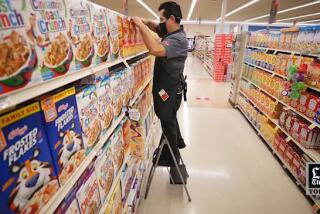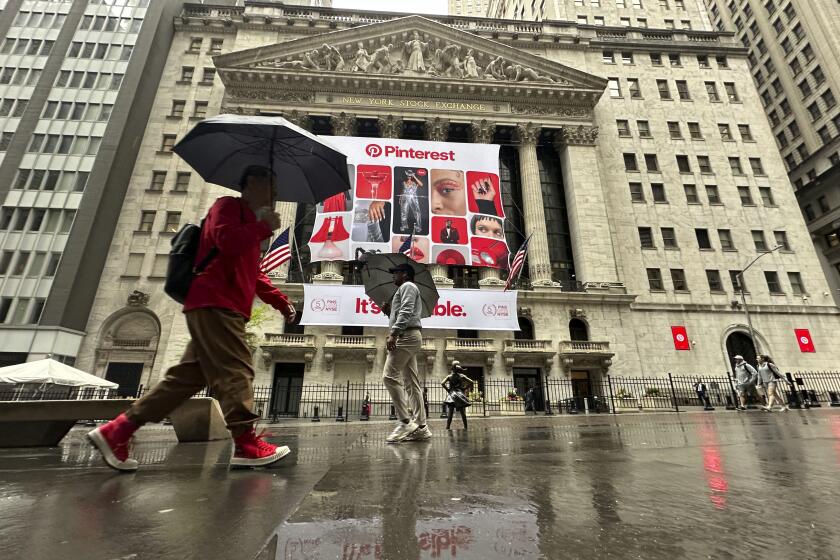Grocery Gargantua : Industry Embraces Mega-Stores
As Manchester Avenue curves west from the Great Western Forum, an 86,736-square-foot behemoth of a grocery store comes into view.
It’s Vons Cos.’ newest effort to lure shoppers in a fiercely competitive Southern California grocery market. On a recent Friday afternoon, the Inglewood store was teeming with people.
They squeezed tomatoes and filled medical prescriptions.
They read greeting cards in the stationery section and dropped off armfuls of dry cleaning.
They waited in line at the Bank of America cubicle and window-shopped next-door at the Frame-n-Lens store.
At long wooden tables next to stacks of fresh produce, they ate pizza and chicken lo mein from the Pizza Classico and Panda Express stalls that, along with a barbecue restaurant and Vons deli, form a kind of mini food court against one wall of the supermarket, which opened in late May.
“This store is wonderful,” gushed shopper Margaret Jamerson, who admired eyeglass frames while her husband visited the bank. The Jamersons have driven several times from their home near Torrance to shop at the Vons. “I have so many errands to run, it’s a convenience to come here. People these days are too busy for anything but convenience,” she said.
That’s exactly what industry experts say is driving supermarkets to build these big “super-combination stores”--akin to indoor strip malls--where shoppers can obtain a variety of goods and services other than groceries. Some non-grocery segments are operated by the supermarket chain, others by independent vendors.
“The whole supermarket industry is consumer-driven, so supermarkets are going to respond to what customers want,” said Sherrie Rosenblatt, a spokeswoman for the Food Marketing Institute in Washington. “Customers don’t want to have to go anywhere else besides the supermarket to rent videos, ship packages, send faxes, get drugs and pick up a quart of motor oil. . . . They want one-stop shopping.”
The Inglewood Vons also includes a travel agency, a party store and a shipping service. It’s the Arcadia-based chain’s fifth combination store to open in 15 months and the first in the Los Angeles area. (The store fulfills part of a pledge Vons made after the 1992 Los Angeles riots to build more stores in underserved inner-city areas.)
Vons is copying an idea tried unsuccessfully in Southern California in the late 1980s by Salt Lake City-based Smith’s Food and Drug.
Smith’s failed in part because it had too many of the combination stores, said Gary Giblen, an analyst with PaineWebber in New York. Vons said it is building combination stores only in selected areas, and Giblen noted that the familiarity of the Vons name might give the chain an advantage with the concept. Vons is Southern California’s largest grocery store chain.
*
Still, analysts said, making a profit in the combination store is a challenge.
“When you build a store like this, it’s really a roll of the dice,” Giblen said. “The break-even point is a lot higher when there’s a lot more fancy stuff built into the store. But the upside is that profitability is higher if the store works.”
Inglewood store manager Mike Courtis said business has been “outstanding.” Vons executives wouldn’t discuss specifics, but they said weekly sales at the Inglewood store have exceeded projections by 25%.
“The customer response has been great,” Courtis said. “They say they are so thankful to have a store like this in their area.”
Independent operators leasing space inside the supermarket also say business is good. Sales at Frame-n-Lens are running 70% higher than expected, manager Annie Clark said.
“We exchange customers with Vons, and this way we get a lot more exposure,” said Clark, who estimated that 40% of her customers are walk-ins from the supermarket. Frame-n-Lens’ Vons location is only a quarter of the size of the former Inglewood Frame-n-Lens, but volume hasn’t slipped, Clark said.
“We get more walk-ins than any other Frame-n-Lens store, and that generates future customers,” she said.
The Bank of America branch relies on Vons to supply 90% of its customers, manager Deedre Chachere-Hunt said.
“We’ve gotten quite a few new customers,” Chachere-Hunt said. “Some people are even switching from other banks because of the convenience.”
Panda Express has been ringing in sales of $2,000 a day and attracts patrons from nearby businesses in addition to shoppers, manager Joe Manahan said. Food items are 10 to 20 cents more expensive than in a free-standing Panda Express restaurant because operating costs are higher at the Vons store, he said.
*
Vons also has higher costs because of the size of the grocery department, said Don Beaver, president of the Sacramento-based California Grocers Assn. He estimated that the Inglewood store will have to attract as many as 35,000 customers a week--and that they will have to spend as much as $700,000, or $100,000 more than at an average-sized supermarket--for Vons to break even.
But the super-combination store is the wave of the future, Beaver said. He estimated that in the near future, 10% of Southern California’s 3,000 supermarkets will be super-combination stores.
The Dublin-based Lucky supermarket chain has some stores with banks, dry cleaners, restaurants and cappuccino bars operated by outside businesses, spokeswoman Judy Decker said.
Compton-based Ralphs, which in the 1980s experimented with but ultimately scaled back its Giant superstores, does not expect to build super-combination stores. It tries to locate in strip malls to provide customers with services such as dry cleaning and eyeglasses, according to spokeswoman Julie Weeks.







